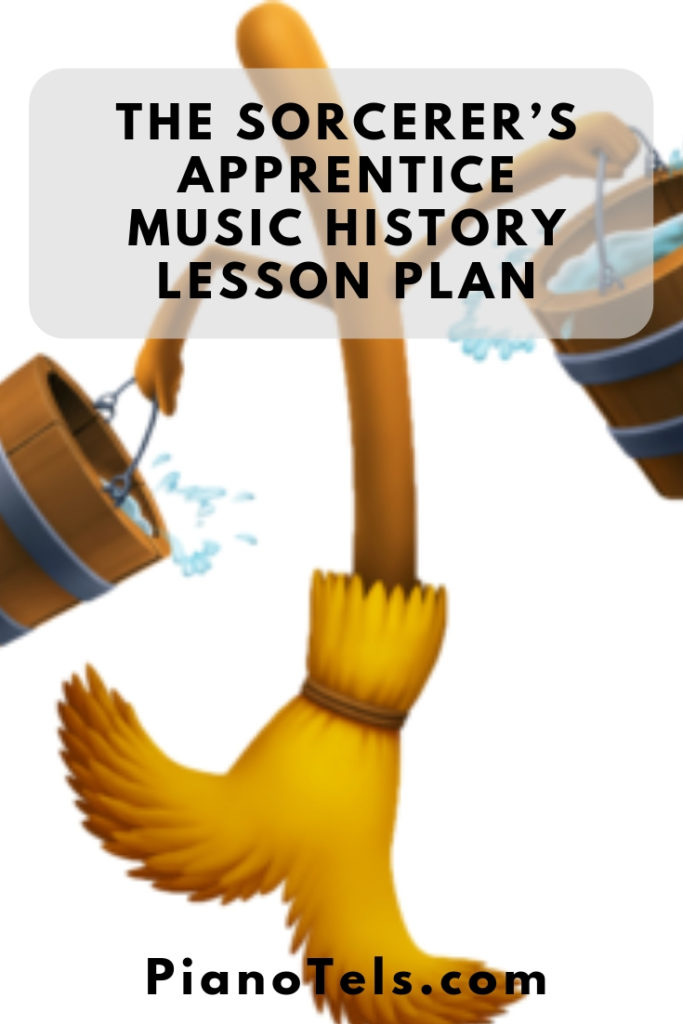
It doesn’t get much better than The Sorcerer’s Apprentice. This is such an exciting song and thanks to Disney’s Fantasia, one that is recognizable for most students. As you know from my post on the importance of teaching music history as can be found here, I just love these musically historical lessons. This is where the student can start to appreciate music, where it came from, and how it got to be famous.
The Sorcerer’s Apprentice teaches us about Paul Dukas, a musician that is very relate-able to the student, being as he didn’t show any particular talent at a young age like many of the other famous composers of our time do. The Sorcerer’s Apprentice is a fantastic way to show how music creates a story. This song was inspired by a poem, and your students can do that, too!
This is a lesson plan that can be used for one student, or for a class of students. It can be used for beginning to intermediate students.
The Sorcerer’s Apprentice Lesson Plan
Objective:
- For the student to be able to identify a dotted quarter note rhythm.
- For the student to be able to identify The Sorcerer’s Apprentice motif.
- For the student to create a listening map of The Sorcerer’s Apprentice.
- For the student to begin an original composition using a nursery rhyme.
Materials and Preparation Needed:
- Drum, or other instrument for rhythm activity in introduction
- Top hat
- Chalk and a chalkboard
- A device to watch and listen to The Sorcerer’s Apprentice
- Paper and coloring utensils to create a listening map
- Cut out different sections of The Sorcerer’s Apprentice motif for use in the Music Application

Introduction:
Welcome the student(s) to class and tell them that we have an exciting lesson ahead! To begin, we will have the student copy the first measure of the teacher for the following rhythms. Then, as a class, do it together. Repeat the songs as many times as you would like. If you would like, show these rhythms and have them identify which rhythm you are playing.
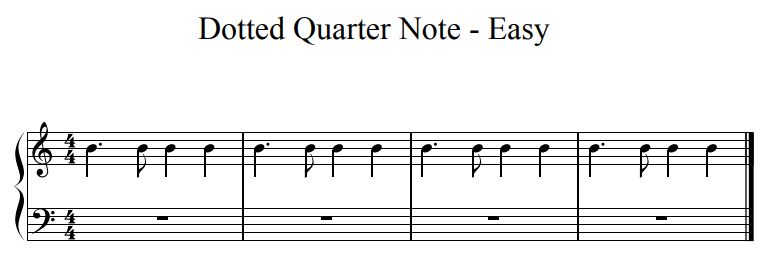


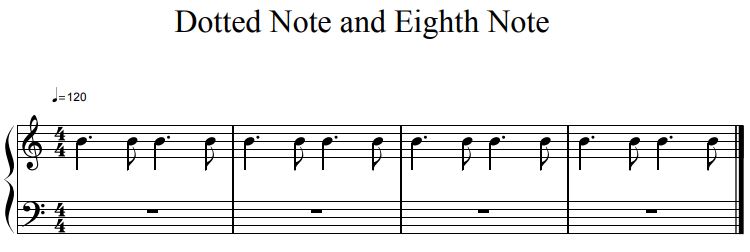
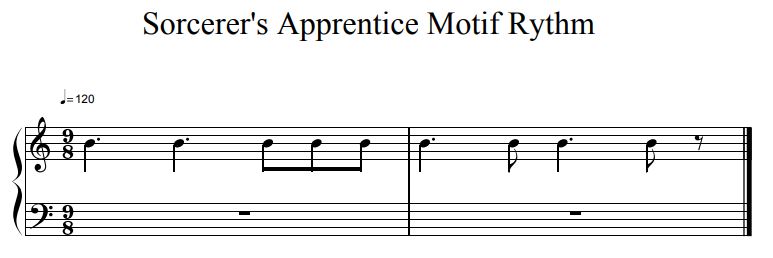
Review and Follow-up:
This is the part of the lesson in which the student(s) can show off what they have been practicing all week for you. Allow the student(s) to show you the things that they feel they have done well. Usually, they are pretty anxious to show me some of those things they have been working hard on. You can follow up with some previously discussed items here, but mostly this is a time to just pat your student on the back for a job well done as they show off to you.
Lesson:
It is always important to make history something that is relevant to the student’s life. In this part of the lesson, we are trying to relate Paul Dukas, the composer, to the life of your student(s).
Paul Dukas
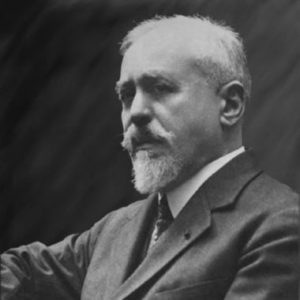
Put on a top hat. Explain that Paul Dukas lived in the early 1900s, where they wore suits and top hats. He was a teacher, which is a grand profession! He taught many students, just like I am teaching you. Back then, electricity was just being invented. It wasn’t very likely that many people had electricity in their homes. At school, they used chalk and a tablet. Not a tablet like you use today, but a tablet was a chalkboard. For this lesson, we are going to use chalk and a chalkboard, just like they did back in the time of Paul Dukas.
So, pull out your chalk and let’s draw a rough outline of the country France. This was where Paul Dukas lived. We live in the United States. France is clear across the ocean. You would have had to ride a boat to get from our country to France back in his day. He started taking piano lessons at 5 years old. (Relate how old he was to how old your student(s) are.) He took lessons and he was pretty good. But you wouldn’t have known he would become a world-famous composer. In fact, he seemed pretty normal. At 14 years old, he got sick. Have you ever been sick? What do you do when your sick? (Lay in bed, and cover yourself with a blanket and try and recover.) I am betting that he got pretty bored while he was sick. He didn’t have devices or TV or Nintendo to entertain him like you do. What would you do if you didn’t have those things and you were just sitting in bed all day? Well, he got creative and started to realize that he could come up with songs in his head and write them down. He started to compose!
Years later, he found a poem that just hit him. He decided to write a song about it. Would you like to hear the poem?
While reading this poem, play The Sorcerer’s Apprentice in the background. See if anybody recognizes the story and/or the song. If you choose to use this link, then listen to the first minute where they explain the story just a little beforehand. Then read the following poem by Johann Wolfgang von Goethe (pronounced GU(R)-tuh). Do NOT show the movie yet. Dramatic reading is obviously very pertinent to this story!
The Sorcerer’s Apprentice
Gone’s for once the old magician
With his countenance forbidding;
I ‘m now master,
I ‘m tactician,
All his ghosts must do my bidding.
Know his incantation,
Spell and gestures too;
By my mind’s creation
Wonders shall I do.
-
- Flood impassive
-
- With persistence
-
- From a distance
-
- Want I rushing
-
- And at last abundant, massive
-
- Here into my basin gushing
Come, old broom!
For work get ready,
Dress yourself, put on your tatters
You ‘re, I know, a servant steady
And proficient in such matters.
On two legs stand gravely,
Have a head, besides,
With your pail now bravely
Off, and do take strides!
-
- Flood impassive
-
- With persistence
-
- From a distance
-
- Want I rushing
-
- And at last abundant, massive
-
- Here into my basin gushing
Like a whirlwind he is going
To the stream, and then in
Like an engine he is throwing
Water for my use; with flurry
Do I watch the steady;
Not a drop is spilled,
Basin, bowls already
Are with water filled.
-
- Fool unwitty,
-
- Stop your going!
-
- Overflowing
-
- Are the dishes.
-
- I forgot the charm; what pity!
-
- Now my words are empty
For the magic charm undoing
What I did,
I have forgotten.
Be a broom!
Be not renewing
Now your efforts, spell-begotten!
Still his work abhorrent
Does the wretch resume;
Where I look a torrent
Threatens me with doom.
-
- No, no longer
-
- Shall I suffer
-
- You to offer
-
- Bold defiance.
-
- I have brains,
-
- I am the stronger
-
- And I shall enforce compliance
You, hell’s miscreate abortion,
Is this house doomed to perdition?
Signs I see in every portion
Of impending demolition.
Servant, cursed and senseless,
Do obey my will!
Be a broom defenseless,
Be a stick!
Stand still!
-
- Not impurely
-
- Shall you ravage.
-
- Wait! you savage,
-
- I’ll beset you,
-
- With my hatchet opportunely
-
- Shall I split your wood, I bet
There he comes again with water! –
How my soul for murder itclies!
First I stun and then I slaughter,
That is good for beasts and witches.
Well! he ‘s gone! – and broken
Is the stick in two.
He ‘s not worth a token;
Now I hope, I do!
-
- Woe! It is so.
-
- Both the broken
-
- Parts betoken
-
- One infernal
-
- Servant’s doubling.
-
- Woe! It is so.
-
- Now do help me, powers eternal!
Both are running, both are plodding
And with still increased persistence
Hall and work-shop they are flooding.
Master, come to my assistance! –
Wrong I was in calling
Spirits, I avow,
For I find them galling,
Cannot rule them now.
-
- “Be obedient
-
- Broom, be hiding
-
- And subsiding!
-
- None should ever
-
- But the master, when expedient,
- Call you as a ghostly lever!”
At this point, discuss with the students about the song and see what thoughts they had. Did they feel like the poem followed the music? Did they sense the frustration and the panic in the young apprentice? What made the music tell the story? What elements in the music caused the story to be told? (You can talk about tempo, dynamics, rhythm choices, etc.)
We are going to watch and listen to The Sorcerer’s Apprentice again, this time watching the story from Mickey Mouse. After watching the video, discuss with the students what things they noticed this time. Did they feel like they have become familiar with the story well enough to create a listening map?
Note: As a student, a listening map helps to bring a visual representation of what they hear. It brings something abstract to something concrete. Noticing the organization of a song will help in understanding music, noticing patterns, and for future composing. Listening maps allow the learner to interact with the music as well.
Provide paper and colored pencils, markers, or whatever you prefer for them to listen again and create a listening map. Offer guidance as needed. Show them an example, if you have one. Though be careful not to allow them to “copy” your example – show it briefly and put it away. This is a time for them to create. There aren’t a lot of “wrong” answers on this one.
Music Application:
Since the students have listened and studied this song extensively, ask them if they could identify a short section of the song that seems to repeat itself. We could call this the “theme” or “motif”. Give an example of a motif that they may be familiar with, such as the theme of Star Wars. Then ask them what the theme of The Sorcerer’s Apprentice would be.
Provide the appropriate sections of the motif and see if they can put them together in the right order. If time permits, you can allow them to listen to the song again and raise their hand every time they hear the motif. Even students who don’t know how to read music well can do this activity. Remind them how music that is higher up on the staff has higher tones. The greater the distance on the staff, the higher the jump in music. Versus small steps can create just a little jump up in the music.
In The Sorcerer’s Apprentice, a dotted quarter note is part of the motif. I like to use this song to help teach the quarter note in a practical way. Point out the dotted half note in the motif. Review how to count out a dotted half note with an eighth note. If they can, have them tap on the drum the different rhythms that we did at the introduction of the lesson, but this time allowing them to read the rhythms on their own.
Compose to Close Variation 1
Have the student choose a favorite nursery rhyme. A simple one is preferred. They can use Jack and Jill, Little Bo Peep, Humpty Dumpty, or any other one. Using the same pattern in which Paul Dukas did in creating music from a poem, have them create a simple melody to accompany the nursery rhyme. It CANNOT be a melody that they already associate with the rhyme. As they do so, encourage them with something that Paul Dukas once told his student, “Always remember that it should be written from the heart and not with the head.”
Share the nursery rhyme and the melody that they create.
Compose to Close Variation 2
*The following is intended for use with students who already know how to read and write music:
Have the students create two measures. In these measures, they are required to have at least one dotted quarter note combined with an eighth note. When they have found a rhythm that they enjoy, write it down in a 4/4 time signature.
Once they have created 2 measures of rhythm including a dotted quarter and eighth note, they can choose notes to go with them. Remind them that often times, music does not have greater intervals than 3rds or 4ths from one note to the next. Encourage them to choose a few notes within the C Major scale to use and then to interchange them within the rhythm they have previously chosen. As they do so, encourage them with something that Paul Dukas once told his student, “Always remember that it should be written from the heart and not with the head.”
More advanced students can add in a left hand to their melody.
*This following is intended for use with students who DON’T already know how to read and write music:
Allow the student to create a rhythm using a dotted quarter note and an eighth note. Allow them to feel what would be a rhythm they would enjoy. Tell them that Paul Dukas once told his students, when composing, “Always remember that it should be written from the heart and not with the head.” Creating a rhythm is a form of composing. Give them the opportunity to try out different keys on the keyboard with their rhythm. Allow them to hear the music, and don’t worry to much about making it sound just right.
The Sorcerer’s Apprentice Lesson Plan Quick Outline
Objective:
- For the student to be able to identify a dotted quarter note rhythm.
- For the student to be able to identify The Sorcerer’s Apprentice motif.
- For the student to create a listening map of The Sorcerer’s Apprentice.
- For the student to begin an original composition using a nursery rhyme.
Materials and Preparation Needed:
- Drum, or other instrument for rhythm activity in introduction
- Top hat
- Chalk and a chalkboard
- A device to watch and listen to The Sorcerer’s Apprentice
- Paper and coloring utensils to create a listening map
- Cut out different sections of The Sorcerer’s Apprentice motif for use in the Music Application
Introduction:
- Students copy teacher’s rhythms on a drum or other instrument
- Copy teacher’s rhythm of The Sorcerer’s Apprentice motif
Review and Follow-up:
- Follow up and review previous week’s lesson
Lesson
- Introduce Paul Dukas
- Read The Sorcerer’s Apprentice by Goethe while listening to it on audio
- Students create a listening map
Music Application
- Put together the previously cut out motif of The Sorcerer’s Apprentice
- Find the motif while listening toThe Sorcerer’s Apprentice
- Teach dotted half note with eighth note rhythm
Compose to Close Variation 1
- Create an original composition using nursery rhymes
- “Always remember that it should be written from the heart and not with the head.” – from Paul Dukas
Compose to Close Variation 2
- “Always remember that it should be written from the heart and not with the head.” – from Paul Dukas
- Create two measures of rhythm in a 4/4 time signature including a dotted half note and eighth note
- Create a melody to go with the rhythm
- Create a left hand to go with this, if they can.
- For those that can’t read music:
- Create a rhythm that would include a dotted half note and an eighth note
- See if they can put some music to their rhythms on a keyboard
Tel loves her life as a piano player, a piano teacher, and a mom. Amid piano blogging, piano teaching, and piano playing, she loves a chance to fit in a good exercise class, volunteer at her kids’ school and at her church, and go on long dates with her husband. Full bio at About Tel.

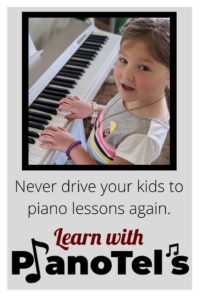
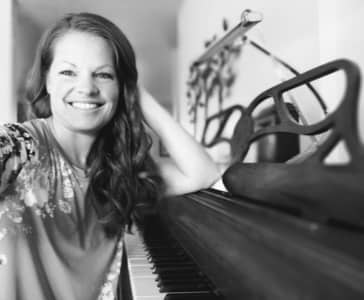
Thank you so much! I can hardly wait to do this with my piano students at our Halloween Piano Party! It’ll be perfect! 🎃🎹